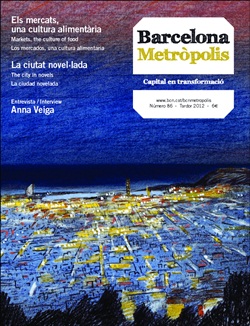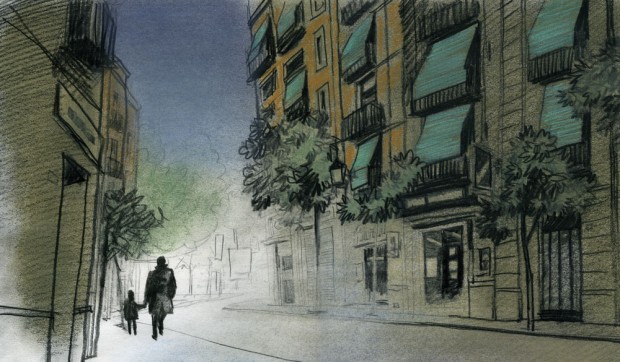The Shadow of the Wind depicts a Gothic city with techniques typical of the audiovisual world. The spirit of the city is raised to the universal on its pages, for which great authors who had looked at Barcelona before act as models.
In 2001, Carlos Ruiz Zafón put the great Barcelona novel on the best-seller map with The Shadow of the Wind. Its merits: tying up with the realist narrative tradition to imagine a gothic city with the arts of the audiovisual. The writer does not pursue historic rigour, but rather creates unforgettable atmospheres. La Rambla is conjured up as “dawn poured” over it in a “wreath of liquid copper”.
Barcelona and its mysteries, like the newspaper serial popularised by Antonio Altadill in the last third of the 19th century. Wrought-iron modernist dragons: foggy stories of melancholy and unease. Topography: the stone-clad Barri Gòtic; the brackish Ribera; the nocturnal Raval; the Gaudiesque Sagrada Família; sprawling middle-class houses in Pedralbes, Sarrià and Tibidabo; Montjuïc, with its castle and cemetery overlooking the sea. From the Barcelona canon, Ruiz Zafón points to titles written in Catalan, such as La febre d’or [Gold fever], by Narcís Oller: the Barcelona of financial ambition in the first great novel of a city shifting towards a modernity that spans 1892 to 1992; and also The Time of the Doves and A Broken Mirror, by Mercè Rodoreda: post-war confidences whispered behind the curtains.
And literature about Barcelona in Spanish, The Truth about the Savolta Case, by Eduardo Mendoza, or the gun law… However, he confesses that the story that had the greatest impact on him was Nada [Nothing], by Carmen Laforet, because “it captures a certain air of the intangible Barcelona”. It is no coincidence, by way of homage, that the winner of the first Nadal Prize was published in May ’45 and The Shadow of the Wind begins precisely in the summer of that same year. The deep impression made on Andrea on reaching the Estació de França train station, where nobody is waiting for her, could be compared to Daniel Sempere delving into an enigmatic Barcelona; both perceive the dank atmosphere of mystery that is both startling and alluring.
The sensitivity of loneliness comparable to the heroines of Rodoreda and her particular way of metabolising colours, scents and objects forgotten amid the shadows of the past. As for Eduardo Mendoza, his parodial sense of humour of the cryptic-critical detectives palpitates in the loquacious and picaresque Romero de Torres, “bibliographic adviser” of the Sempere bookshop who struggles, with ironic erudition, against the acid reflux of a brooding personal memory.
Ruiz Zafón also draws attention to the work of Juan Marsé and, for its documentary value, Mariona Rebull and El viudo Rius [The Widower Rius], by Ignacio Agustí. El viudo Rius personifies the textile manufacturer of Barcelona whose days are frittered away amid the balances of economic protectionism – a topic also taken up by Oller – and his obsession with a woman. We see him accompany his son Desiderio to the Piarist school in Sarrià: “It was as if they had moved to another city, another world.” The Piarist school is very close to the Jesuits, where the author of The Shadow of the Wind studied and wanted Julián Carax to study: “Its redbrick façade dotted with dagger-shaped windows, stood in the middle of a grove, at the top of a narrow, winding street that led up from the boulevard. The whole structure, crowned by arches and towers, peered over a group of plane trees like some Gothic cathedral.” In this middle-class school, Ruiz Zafón conjugates family secrets with the “Mendozian” irony of haunted crypts: “In its heyday – say between 1880 and 1930, more or less … [it] … took in the flower of old, established families with bulging wallets.”
The passageways and cityscapes travelled by the nouveau riche Gil Foix of La febre d’or – Carrer Ample, Plaça del Palau, la Llotja, the Ciutadella of the 1888 Universal Exhibition and also the mountain of Montjuïc – provide the backdrop for the Barcelona of Ruiz Zafón and Eduardo Mendoza. The former spins his plots in this cityscape, and the Mendoza of the City of Marvels gives the name of Delfina – the same as Gil Foix’s daughter – to the girl from the hostel where Onofre Bouvila embarks upon his rise to financial success. Taking these authors in Catalan or in Spanish as his references, Ruiz Zafón seeks to share a “take” on a Barcelona which is only possible in literature; to have us relate to his characters’ sensations. An exercise that should not be confused with a form of nostalgia that strikes him as dangerous and inexact.
More favourite authors, beyond the Barcelona canon: Charles Dickens and Stephen King. The connection with the newspaper serial and the “monstrous” mystery leads us to the Borgesian Cemetery of Forgotten Books in the gloom of the Calle Arco del Teatro; there, the impulse of the treasure hunter drives Daniel Sempere towards the book signed by Julián Carax, the accursed writer: “There was a time, in my childhood, when, perhaps because I had been raised among books and booksellers, I dreamed of becoming a novelist.” The spirit of that eternal and suggestive Barcelona flaps its wings, to take universal flight, in the pages of The Shadow of the Wind.





Pingback: Torna Barcelona Metròpolis | Núvol